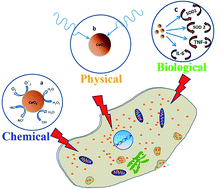Radioprotective effects of ultra-small citrate-stabilized cerium oxide nanoparticles in vitro and in vivo†
Abstract
A comprehensive study of the radioprotective action mechanisms of ultra-small, citrate-stabilized, nanocrystalline cerium oxide (CeO2 nanoparticles, nanoceria) in vitro and in vivo was carried out. CeO2 nanoparticles were shown to significantly reduce the levels of hydrogen peroxide and hydroxyl radicals in aqueous solutions under X-ray irradiation. Pretreatment of primary mouse fibroblasts by CeO2 nanoparticles in a wide range of concentrations (10−5 to 10−9 M) protects cells from radiation-induced oxidative stress, maintaining a high level of dehydrogenase activity. A protective effect of CeO2 nanoparticles is also manifested in a decrease in the number of apoptotic cells and the level of reactive oxygen species (ROS) in a culture of primary mouse fibroblasts in vitro, as well as in a significant reduction (up to 50% of the control) of cytogenetic damage of mouse bone marrow in vivo. The intraperitoneal administration of CeO2 nanoparticles (200 nM) increased the rate of survival of mice exposed to X-ray radiation at a lethal dose, both in the prophylactic and the therapeutic schemes of administration, testifying the protection at the molecular, cellular and organism levels. The physical, chemical and biological origins of the protective action of CeO2 nanoparticles upon exposure of living systems to ionizing radiation in vitro and in vivo are discussed.



 Please wait while we load your content...
Please wait while we load your content...